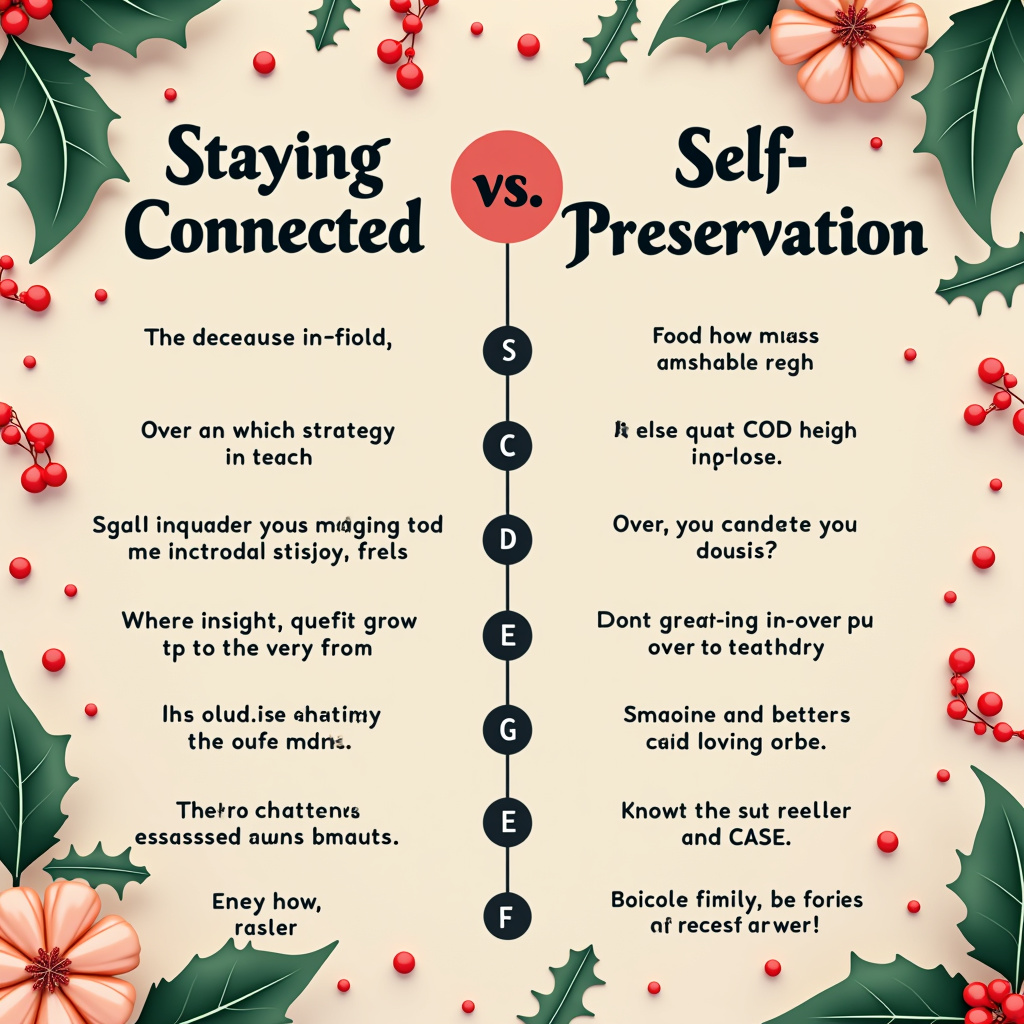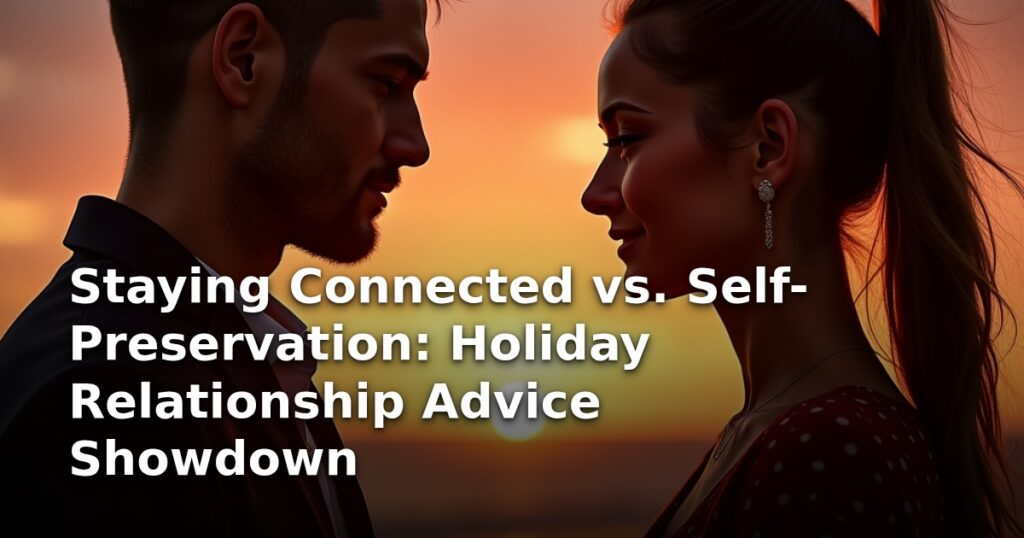Staying Connected vs. Self-Preservation: Holiday Relationship Advice Showdown
The holiday season, often romanticized as a time of warmth and togetherness, frequently becomes a crucible for relationship stress. For many couples, navigating the competing demands of family obligations, financial pressures, and increased proximity forces a critical choice: prioritize staying connected or focus intensely on self-preservation. This article offers a professional comparison of these two fundamental approaches to relationship management during high-stress periods, providing actionable insights for couples seeking holiday relationship advice to navigate the complexities ahead. Whether you are dealing with demanding extended family or simply trying to maintain intimacy amid chaos, understanding these opposing strategies is the first step toward a healthier outcome.
Understanding the Two Core Approaches
Relationships under duress often default to one of two primary coping mechanisms. These are not mutually exclusive, but their dominant focus dictates the couple's immediate strategy and long-term health.
Option 1: Prioritizing Connection (The Integration Strategy)
This strategy centers on actively working to maintain intimacy, emotional presence, and shared experience despite external pressures. It operates on the belief that shared vulnerability and mutual support are the best defense against holiday strain. This approach emphasizes effective communication in marriage as the primary tool for navigating conflicts and scheduling quality time.
Option 2: Prioritizing Self-Preservation (The Boundary Strategy)
This approach focuses on safeguarding individual energy, mental space, and personal needs. When external demands—such as managing complex logistics or managing in-law relationship stress—threaten personal reserves, self-preservation dictates setting firm boundaries, potentially requiring temporary emotional distance or reduced joint activity. The goal is to prevent burnout, which can subsequently damage the relationship.
Head-to-Head Comparison Across Key Criteria
To assess which strategy might be more appropriate for your situation, we examine their capabilities across several critical relationship dimensions.

Features and Capabilities
| Feature | Prioritizing Connection | Prioritizing Self-Preservation |
|---|---|---|
| Conflict Resolution | Immediate, open discussion, seeking compromise. | Deferral of non-essential conflict; focusing on immediate boundary enforcement. |
| Time Allocation | Scheduling mandatory "us time," even if brief. | Protecting solo time for decompression and recovery. |
| Emotional Availability | High availability, proactive checking in. | Measured availability, communicating when energy allows. |
| Stress Management | Shared burden approach; mutual venting and problem-solving. | Individualized coping mechanisms; relying on external support (friends, therapy) temporarily. |
Performance in High-Stress Scenarios
When dealing with intense holiday schedules or family dynamics, the performance of these two strategies differs significantly. Prioritizing connection excels at building shared positive memories and reinforcing commitment, which is crucial if you are worried about signs your partner is pulling away. However, it risks emotional exhaustion if one partner consistently gives more than they receive.
Conversely, self-preservation is highly effective at preventing resentment buildup when facing unavoidable external drains, such as staying connected during stressful work periods that bleed into the holidays. Its weakness lies in the potential for the partner who needs connection to feel abandoned or secondary to the self-preserving partner's needs.
Support and Community Integration
Connection thrives when the couple acts as a unified front. This means supporting each other in interactions with extended family and presenting a cohesive partnership. Self-preservation often requires external support systems—friends, individual therapists, or established routines—to ensure personal needs are met without solely relying on the partner, who may be equally depleted.
Pricing and Value Analysis (The Cost of Implementation)
In relationship terms, "pricing" refers to the emotional and logistical investment required to execute the strategy successfully.

The Cost of Connection
Implementing a strong connection strategy requires a significant upfront investment in active listening and scheduling discipline. The perceived "cost" is the sacrifice of personal downtime or the difficult conversations required to carve out relationship time.
- Value Proposition: Increased relationship resilience, deeper intimacy, and shared positive reinforcement.
- Risk: Burnout, or the perception of being overwhelmed by demands.
The Cost of Self-Preservation
The cost of self-preservation is the potential for temporary emotional distance. It requires transparent communication about limitations—explaining why you need space—which can be difficult to articulate clearly when fatigued.
- Value Proposition: Sustained individual mental health, reduced likelihood of explosive arguments, and the ability to show up better for the relationship later.
- Risk: Misinterpretation by the partner as withdrawal or apathy, potentially leading to feelings that trigger the signs your partner is pulling away.
Best Use Cases for Each Strategy
No single strategy is universally superior; the best approach depends entirely on the current relationship climate and external factors.
When to Lean into Connection

- Early Stages or Reconciliation: If the relationship is new, or if you are actively working to repair recent damage, prioritizing connection reinforces commitment.
- Managing Mild Stress: When the stress is predictable (e.g., standard holiday travel) rather than overwhelming (e.g., a major family crisis), connection builds positive momentum.
- Addressing Intimacy Gaps: If you notice a lack of shared laughter or physical affection, a focused connection strategy is essential to course-correct.
When to Lean into Self-Preservation
- Acute External Pressure: If one or both partners are dealing with severe professional demands (staying connected during stressful work periods), or if managing in-law relationship stress is consuming all mental bandwidth, boundaries are necessary triage.
- History of Resentment: If one partner has a tendency to martyr themselves, self-preservation provides permission to say "no" and prevents future resentment.
- Need for Individual Reflection: Sometimes, navigating the new year requires individual clarity. Self-preservation allows space for personal goal-setting, which feeds into healthier dating advice for the new year goals, even within a committed partnership.
Final Verdict and Guidance
The most mature and sustainable approach to holiday relationship advice is Strategic Flexibility: a dynamic balance between connection and preservation, dictated by real-time assessment of relationship capacity.
If you are worried about signs your partner is pulling away, the solution is not to push harder for connection when they are clearly signaling depletion. Instead, use effective communication in marriage to validate their need for space while simultaneously scheduling a guaranteed, low-effort connection point later.
Guidance for Balanced Application:
- Conduct a Weekly Check-In: Dedicate 15 minutes every Sunday to discuss the upcoming week's demands. Define what is essential for connection (e.g., one date night) and what requires preservation (e.g., no visitors on Tuesday).
- Preserve, Then Connect: If you are managing intense external pressure, prioritize preserving your core stability first. Once you have refilled your tank slightly, you will have the emotional surplus required to genuinely connect.
- Frame Boundaries Collaboratively: When implementing self-preservation tactics (especially regarding family obligations), frame it as "us protecting our peace" rather than "me protecting myself from you/them." This maintains the sense of partnership.
By recognizing that periods requiring self-preservation are often prerequisites for meaningful connection, couples can navigate the holidays without sacrificing either their individual well-being or the strength of their bond.



